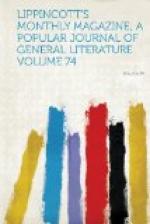The farms in this neighborhood are mostly small, the average being seventy acres, and some are still smaller, though when one gets down to ten, one is tempted to call them gardens. Grazing and dairy-work are the chief industries. Farther inland, beyond the manufacturing town of Stockport, is a house of the Leghs, an immense building, more imposing than lovely in its exterior, but one of the most individual and pleasant houses in its interior as well as in its human associations. It has been altered at various times, and bears traces, like a corrected map, of each new phase of architecture for several hundred years. The four sides form a huge quadrangle, entered by foreign-looking gateways, and the rooms all open into a wide passage that runs round three sides of the building, and is a museum in itself. Old and new are just enough blended to produce comfort, and the stately, old-English look of the drawing-room, with its dark panelling and tapestry, is a reproach to the pink-and-white, plaster-of-Paris style of too many remodelled houses. Outside there is a garden distinguished by a heavy old wall overrun with creepers, dividing two levels and making a striking object in the landscape; and beyond that, where the country grows bleak and begins to remind one of moors, there are the last survivors of a unique breed of wild cattle, which, like the mastiffs at the house, bear the name of the place. The name of another Cheshire house, formerly belonging to the Stanleys, and now to Mr. Gladstone, is probably familiar to American readers—Hawarden Castle. The present house must trust entirely to associations for its interest, having been built in 1809, before much taste was applied to restore old places, but the old castle in the park dates from the middle of the thirteenth century. The park is not unlike that of Arundel, but the views from the ruin are finer and more varied. The counties of Caernarvon, Denbigh, Flint, Cheshire and Lancashire are spread out around it, and the ruin itself is beautiful and extensive.
The road from Hawarden to Boughton is exceedingly grand: we come upon one of the widest panoramas of the Dee and one of the most typical of English country scenes. A vast sweep of country unsurpassed in richness spreads along the river on the Cheshire side: sixty square miles of fields and pastures are in sight, with elms, sycamores and formal rows of Lombardy poplars. Wherever the trees cluster in a grove they usually mark the site of a country-house or a cherished ruin, like this one of old Hawarden, where one enormous oak tree sweeps its branches on the ground on every side, and forms a canopy whence you can peer out, as through the delicate tracery of a Gothic window, at the landscape beyond. The mouth of the Dee is visible from this road, whence at low water it seems reduced to a huge sandbank, through which the tired river trickles like a brook. The dun sky and yellow sands and gray sea, with the island of Hilbree, a counterpart of Lindisfarne both




